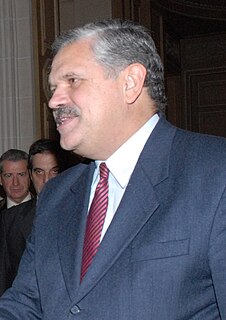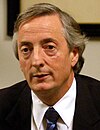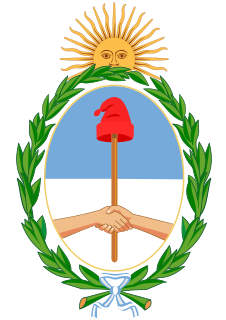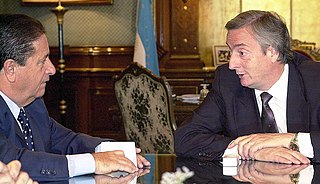Background
For the first time since the return of democracy in 1983, the Justicialist Party (PJ) failed to agree on a single presidential candidate. Three credible Peronist candidates ran in the election: center-right former President Carlos Menem, center-left Santa Cruz Province Governor Néstor Kirchner, and centrist San Luis Province Former president Adolfo Rodríguez Saá. [1] None were officially supported by the party, though President Eduardo Duhalde publicly endorsed Governor Kirchner on January 15, 2003. The PJ suspended its January 24 convention, opting to allow the three contenders to run on the Peronist mantle. None of the candidates were allowed to use the traditional Peronist iconography in detriment of the others. [1]

The Justicialist Party, or PJ, is a Peronist political party in Argentina, and the largest component of the Peronist movement.

San Luis is a province of Argentina located near the geographical center of the country. Neighboring provinces are, from the north clockwise, La Rioja, Córdoba, La Pampa, Mendoza and San Juan.
For the first time since 1916, the UCR did not field a presidential candidate. [1] After the political collapse at the peak of the economic crisis that led to the resignation of President Fernando de la Rúa at the end of 2001, popular support for the UCR was at historically low levels. Two strong former members of the UCR founded parties based on their politics: Congresswoman Elisa Carrió founded a left-of-center party, the ARI, and economist Ricardo López Murphy founded a right-wing one, Recrear .

Fernando de la Rúa is an Argentine retired politician of the Radical Civic Union (UCR) who served as President of Argentina from December 10, 1999, to December 21, 2001. De la Rúa was born in Córdoba; he entered politics after graduating with a degree in law. He was elected senator in 1973 and unsuccessfully ran for the office of Vice President as Ricardo Balbín's running mate the same year. In 1993, he was re-elected senator in 1983 and 1993, and as deputy in 1991. He unsuccessfully opposed the pact of Olivos between President Carlos Menem and party leader Raúl Alfonsín, which enabled the 1994 amendment of the Argentine Constitution and the re-election of Menem in 1995.

Elisa María Avelina "Lilita" Carrió is an Argentine lawyer, professor and politician, who is an Argentine National Deputy for Buenos Aires. She was the founder of the Argentine political party Civic Coalition ARI.

Ricardo Hipólito López Murphy is an Argentine economist and politician.
These five strong candidates were practically tied in all the pre-election polls. Menem obtained the most votes in the first round, but far short of a first-round victory (about 25%), so a runoff election against Kirchner was required, and was scheduled for May 18. However, after two terms in office from 1989 to 1999, Menem's popularity remained very low. All signs pointed to a record victory for Kirchner (polls showed him leading Menem by anywhere from a 35 to a 50% margin). [2] [3] [2] Rather than face a humiliating defeat, Menem withdrew from the runoff on May 14, a move that was roundly criticized by the other candidates. [4] [3] The courts refused to authorize a new election, and also refused to sanction a runoff between Kirchner and López Murphy (though the latter let it be known he would not take part in any case). Finally, Congress sanctioned Kirchner as president-elect, with the lowest vote share ever recorded for a president in a free election.
The ballotage system is included in the Constitution of Argentina. It was added by the 1994 amendment, as part of the negotiations between Raúl Alfonsín and President Carlos Menem.
Legislative races
Legislative and gubernatorial elections were held throughout 2003, with polls open in different provinces between April and November; average turnout was 70.8%. [5]
These elections were unprecedented in their staggered scheduling; indeed, legislators and governors were chosen over 15 different dates, during 2003. They were also, however, a return to political normalcy following a chaotic and economically depressed 2002.
The Justicialist Party, which was divided among three candidates in the presidential race, remained largely united in legislative and local races. They added 12 seats in the Argentine Chamber of Deputies, as well as 2 governorships, and fears of a high number of dissident tickets did not materialize.

The Chamber of Deputies is the lower house of the Argentine National Congress. It is made up of 257 national deputies who are elected in multi-member constituencies corresponding with the territories of the 23 provinces of Argentina by party list proportional representation. Elections to the Chamber are held every two years; half of its members are renewed each election.
The centrist Radical Civic Union, senior partners in the ill-fated Alliance that had returned them to power in 1999, were left with their smallest representation since 1954, though they were not replaced by the center-left ARI in a significant way; the ARI added but 2 Congressmen.
Voters sentiment improved over 2001 levels (when the sentiment among many was that "they should all go"), though not significantly. Turnout increased only modestly, and the use of invalid votes declined from 24% to 15% from the tense 2001 elections. Voters in the important Santa Fe Province, in particular, curbed their use of spoiled ballots from 30% to 20%. [6]
Kirchner ended 2003 on a more secure footing than before these local and legislative elections. He benefited from allies such as the new governor of the paramount Buenos Aires Province, Felipe Solá, as well as the Mayor of Buenos Aires, Aníbal Ibarra. Argentina celebrated 20 years of continuous democratic rule on December 10, 2003, with a new government carrying generous numbers of allies in Congress and the provinces, as well as voters' high expectations. [6]
This page is based on this
Wikipedia article Text is available under the
CC BY-SA 4.0 license; additional terms may apply.
Images, videos and audio are available under their respective licenses.































